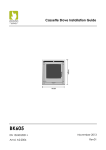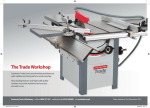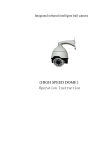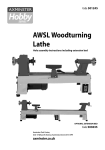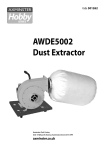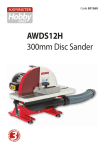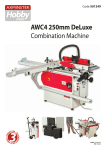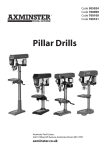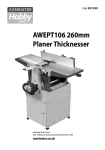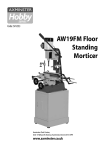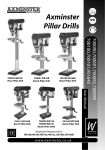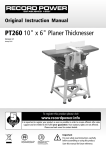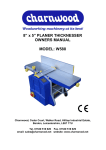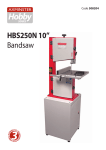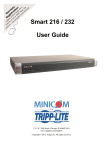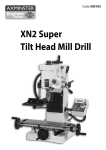Download Axminster AW106PT2 Specifications
Transcript
Code: 501202 Code: 501203 Code: 501204 AW106PT2 AW128PT & AW168PT Planer/Thicknesser 501202 (AW106PT2) 501203 (AW128PT) 501204 (AW168PT) Axminster Tool Centre, Unit 10 Weycroft Avenue, Axminster, Devon EX13 5PH axminster.co.uk Index of Contents Page No. Index of Contents Declaration of Conformity What’s Included General Instructions for 230V Machines Specific Precautions Using Planer Thicknessers Specifications Initial Assembly and Setting Up Machine Illustration and Parts Description Operating Illustrations Changing the Planer Blades Routine Maintenance Parts List/Drawing 1 (AW106PT2) Parts List/Drawing 2 (AW106PT2) Parts List/Drawing 3 (AW106PT2) Parts List/Drawing 4 (AW106PT2) Parts List/Drawing 1 (AW128PT-AW168PT) Parts List/Drawing 2 (AW128PT-AW168PT) Parts List/Drawing 3 (AW128PT-AW168PT) Parts List/Drawing 4 (AW128PT-AW168PT) Notes 02 02 03 03-04 04-05 05 06-07 08-09-10-11 12-13 14-15-16 17-18-19 20-21 22-23 24-25 26 27-28 29-30 31-32 33 34-35 Copied from CE Certificate The undersigned, F.Recherburg authorised Laizhou Planet Machinery Co., Ltd. No. 989. North Laizhou Road 261400 Laizhou Shandong P.R.China declares that this product: The undersigned, authorised Laizhou Planet Machinery Co., Ltd. No. 989. North Laizhou Road 261400 Laizhou Shandong P.R.China declares that this product: ML392 ML393 ML394Q/C2-410Q manufactured by Laizhou Planet Machinery Co. is in compliance with the following standards or standardisation documents EC Directive 98/37/EC Artlcle 8, section 2b Machinery in accordance with the Council Directive 98/37/EC. manufactured by Laizhou Planet Machinery Co. is in compliance with the following standards or standardisation documents EC Directive 98/37/EC Artlcle 8(2)b, or Article 8(2)c, Machinery in accordance with the Council Directive 98/37/EC. manufactured by Laizhou Planet Machinery Co. is in compliance with the following standards or standardisation documents 2006/95/EC The undersigned, G. Reimann authorised Laizhou Planet Machinery Co., Ltd. Yutai West Street, Laizhou, Shandong 261400 P.R.China declares that this product: symbols below advise that you follow the correct Warning The safety procedures when using this machine. Fully read manual and safety instructions before use 02 Ear protection should be worn Eye protection should be worn Dust mask should be worn HAZARD Motor gets hot What’s Included Model Numbers: ML392-ML393 (501202 & 501203) ML394Q/C2-410Q (501204) 1 No. AW106PT2 / AW128PT / AW168PT Planer Thicknesser (95% assembled) 1 No. Planer Fence 1 No. 1 No. 1 No. 1 No. 1 No. 1 No. 2 No. 2 No. 2 No. 1 No. 1 No. 1 No. 1 No. 2 No. 1 No. 1 No. Planer Fence Mounting Base Fence Securing Bracket Overhand Planer Guard Mounting Bracket Overhand Planer Guard Overhand Planer Guard Locking Plate Spring Metal Plate M10 Washers M10 Lever Handle Bolts M6 x 12mm Caphead Bolts 3mm Allen Key 4mm Allen Key 5mm Allen Key 6mm Allen Key M6 Eye Bolts (for lifting) 7mm x 5.5mm Open ended Spanner Instruction Manual Having unpacked your saw and its accessories please dispose of any unwanted packaging properly. The packaging is biodegradable. General Instructions for 230V Machines Good Working Practices/Safety The following suggestions will enable you to observe good working practices, keep yourself and fellow workers safe and maintain your tools and equipment in good working order. WARNING!! KEEP TOOLS AND EQUIPMENT OUT OF THE REACH OF YOUNG CHILDREN Mains Powered Tools Primary Precautions These tools are supplied with a moulded 13 Amp. Plug and 3 core power cable. Before using the tool inspect the cable and the plug to make sure that neither are damaged. If any damage is visible have the tool inspected/repaired by a suitably qualified person. If it is necessary to replace the plug, it is preferable to use an ‘unbreakable’ type that will resist damage on site. Only use a 13 Amp plug, and make sure the cable clamp is tightened securely. Fuse as required. If extension leads are to be used, carry out the same safety checks on them, and ensure that they are correctly rated to safely supply the current that is required for your machine. Work Place/Environment The machine is not designed for sub-aqua operation, do not use when or where it is liable to get wet. Do not use 230V a.c. powered tools anywhere within a site area that is flooded or puddled, and do not trail extension cables across wet areas. Keep the machine clean; it will enable you to more easily see any damage that may have occurred. Continues Over.... 03 General Instructions for 230V Machines Keep the work area as uncluttered as is practical, this includes personnel as well as material. Under no circumstances should CHILDREN be allowed in work areas. It is good practice to leave the machine unplugged until work is about to commence, also make sure to unplug the machine when it is not in use, or unattended. Always disconnect by pulling on the plug body and not the cable. Once you are ready to commence work, remove any tools used in the setting operations and place safely out of the way. Re-connect the machine. Carry out a final check e.g. check the cutting tool is securely tightened in the machine, check you have the correct speed and function set, check that the power cable will not ‘snag’ etc. Make sure you are comfortable before you start work, balanced, not reaching etc. Wear the appropriate safety clothing, goggles, gloves, masks etc. Wear ear-defenders at all times,iIf you wear your hair in a long style, wearing a cap, safety helmet, hairnet, even a sweatband, will minimise the possibility of your hair being caught up in the rotating parts of the machine, likewise, consideration should be given to the removal of rings and wristwatches, if these are liable to be a ‘snag’ hazard. Consideration should also be given to non-slip footwear, etc. If you are allowing another person to use the machine, ensure that they are suitably qualified to use it. Do not use the machine if you are tired, your attention is wandering or you are being subjected to distraction. Do not use this machine within the designated safety areas of flammable liquid stores or in areas where there may be volatile gases. Check that cutters are the correct type and size, are undamaged and are kept clean and sharp, this will maintain their operating performance and lessen the loading on the machine. Above all, OBSERVE…. make sure you know what is happening around you, and USE YOUR COMMON SENSE. Specific Precautions Using Planer Thicknessers Most machines currently, are well interlocked to ensure that the machine must be in the correct configuration to perform one task or the other. Make yourself familiar with these configurations and do not try to use the machine in a half and half state; or rig the interlocks to enable you to do so. Overhand planing These machines are designed for cutting timber only. They will, but are not designed to, cut timber derivatives or composites. Glue lines in plywood, block board etc, will ‘notch’ blades as sure as eggs is eggs. The bonding agent in chipboard is likewise detrimental to the health of your planer irons. Disengage the autofeed for the thicknesser. It is best to leave them alone. If you have to machine composites, work out the costs of tungsten, against HSS (plus the sharpening costs), and proceed accordingly. On larger machines it is common practice to leave a portion of the blade (usually the offside 30 mm) to be used on ‘aggressive’ materials. 04 Continues Over.... Make sure during overhand planing operations, that the fence is set to the required angle, is securely fastened and locked in position. Ensure the planer block guarding is in position and secured. Ensure both tables are correctly seated and locked down. Ensure the dust extraction hood is in place and is not blocked. Fit dust extraction. Check the sharpness of planer irons, check for ‘nicks’ and ‘notches’, if there are damaged sections on the blades, try to plane in the ‘clear’ areas.Especially when planing material down to ‘thin’ dimensions, maintain Specific Precautions Using Planer Thicknessers pressure on the ‘front’ of the material i.e., that portion of the stuff that has passed over the block, but use a push stick or a pusher shoe to clear the end of the stuff over the block. foul any stuff being passed through the machine. Check the height of the thicknessing table. Engage the autofeed mechanism. Thicknessing When thicknessing, remove the fence. Lower the thicknessing table slightly. Unlock and swing both tables ‘up and out of the way’,taking care not to foul the overhand guard/arm assembly, which will probably swing free. Turn the dust extraction hood up and over the block. Periodically, clean any excess build up of resin from the thicknessing table, and apply any proprietary brand of lubricating agent. NOTE, Consideration should be given to the type of finish you will be applying to the surface when you select your cleaning/lubrication agent. Connect the dust extraction. Ensure the hose will not Specifications Model AW106PT2 AW128PT AW168PT 501202 501203 501204 Rating Trade Trade Trade Power 1,500W 2.2kW 3.0kW Product Code Feed Speed Cutterblock Speed Cutterblock Diameter 8m/min 8m/min 8m/min 4,000rpm 4,000rpm 4,000rpm 80mm 95mm 95mm Max Thicknesser Capacity 180mm 220mm 220mm Max Planing Width 250mm 310mm 410mm Max Depth of Cut 2.5mm 5mm 5mm in surfacing mode Max Depth of Cut Thicknesser 3.0mm 2.5mm 2.5mm Max Depth of Cut Planer 1.5mm 1.5mm 1.5mm HSS(Resharpenable) x 3 HSS(Resharpenable) x 4 HSS(Resharpenable) x 4 260 x 1,090mm 310 x 1520mm 1,600mm 1,000m³/hr 1,500m³/hr 1,500m³/hr Knives Length of Table Min Extraction Airflow Required Dust Extraction Outlet Overall L x W x H Weight 100mm 125mm 125mm 1,090 x 750 x 1,000mm 1,520 x 600 x 1,070mm 1,700 x 600 x 1,000mm 150kg 325kg 343kg 05 Initial Assembly and Setting Up Your machine comes enclosed in a packing case with the accessories packed on top of the tables.Having removed the top and the sides of the packing case, remove all the components from the top of the machine; put to one side. Ascertain the orientation of the machine and move it to its desired position in the workshop. Ensure that the machine is positioned to allow sufficient clearance both in front and behind the machine to cater for the maximum length of timber you will wish to machine. Remember sufficient space must be left ‘around’ the machine to facilitate your stance when overhand planing and moving from end to end of the machine if you are thicknessing singlehandedly. Remember that when the surface tables are ‘up and out of the way’ for thicknessing, the machine is appreciably wider than when it is in overhand mode. The machine is bolted down on to the pallet that forms the bottom of the packing case. Remove these ‘hold down’ bolts. In the packet on top of the tables you will find 2 No. small ‘eye’ bolts. These screw into the top part of the machine casting (as shown in fig 1.) and can be used to hoist the machine clear of the pallet. If you do not have the availability of such a hoist, and are going to have to ‘manhandle’ the machine off the pallet; make sure the tables are locked down before applying any lifting force to them. IT IS NOT RECOMMENDED THAT LIFTING, PULLING OR PUSHING IS CARRIED OUT AGAINST THE TABLES. However, if expediency dictates that this is the only method to dismount the machine, this is what must be done. Do Not under normal circumstances lift, push or pull the machine using the tables. Any movement is best carried out against the main frame cabinet. The machine should be positioned on a flat level surface. Final levelling can be accomplished using the levelling bolts in the base fillets of the legs. Once the machine is in position, and level, it can be bolted to the floor if so required. 06 Before adding the fence and the guarding (i.e. with the machine ‘clean’) it is a good idea to remove the protective grease film that is coating all the unpainted parts of the machine. Use a proprietary de-greasing agent or paraffin et al. Unfortunately, this cleaning process is always a bit ‘mucky’, you are advised to wear overalls or coveralls etc., during the process. After cleaning, especially if you used paraffin, lightly coat the exposed metal surfaces to prevent any rusting. Bear in mind the stuff you will be machining and its possible finishing process, when you choose your anti-corrosion agent. Locate the planer fence, the planer fence base, the two handled clamp nuts and washers. Bolt the ‘T’ yoke to the planer fence base. Span the bosses of the ‘T’ yoke with the two elongated slotted lugs of the fence which are loosely bolted into the fence. Fasten the fence to the yoke using the handled clamp nuts and washers, position the fence as required and fasten the four bolts that secure the mounting lugs. Your AW106PT2, AW128PT and AW168PT offers the facility of your being able to plane right or left handed. Decide on the best and most comfortable position for you. Locate the fence mounting bracket and fix to the machine casting as shown in fig 2, using 2 No. M6 x 12mm caphead bolts; depending on your preferred handing. Introduce the planer fence base into the bracket; so that the planer fence base slides into the fence mounting bracket; then secure; positioning the fence approximately mid-table (see fig 3). Mount the overhand plane guard arm onto the side of the outfeed table that corresponds to your preferred handing,then fit the overhand cutter block guard. In the accessories packet there is a small spring metal plate - this fits into the overhand guard clamping assembly to spread the load of the guard clamp onto the guard. It also prevents the bolt scoring the upper surface of the guard,fasten in position using the guard lock (see fig 4). Initial Assembly and Setting Up Typ.2 small eye bolts Fig 1 Typ.2 M6 x 12mm caphead bolt Fig 2 Fence mounting bracket Typ. 2 elongated fence support brackets Planer fence base Typ. 2 handled clamp nuts Fig 3 Fence mounting bracket Fence securing clamp NOTE: The pictures in this manual show the AW106PT2, the AW128PT & AW168PT is exactly the same but on a larger scale. 07 Machine Illustration and Parts Description Fig 4 Cutter block guard clamp Mounting arm height adjustor knob Cutter block guard angle adjustor Spring metal plate Infeed table Outfeed table Infeed table adjustor Table extension Start/Stop switches Overhand cutter guard mounting arm Thicknessing table rise and fall control Thicknessing table rise and fall clamping handle Dust extraction hood 08 Outfeed table adjustor Machine Illustration and Parts Description Cutter block guard clamp Cutter block Cutter block guard angle adjustor Fence securing clamp Fence assembly Mounting arm height adjustor knob Cutter block guard Fig 5 Main chassis Outfeed table lock Start/Stop switches Cutter block guard mounting arm lock handle Autofeed engage control Thicknessing rise and fall scale Start/Stop switches Thicknessing table Main chassis Emergency stop 09 Machine Illustration and Parts Description Cutter block guard angle adjustor Mounting arm height adjustor knob Cutter block guard clamp Fig 6 Cutter block guard Infeed table adjustor mounting arm lock handle Infeed scale for overhand Infeed table lock Fig 7a 10 Infeed table adjustor Fig 7 Machine Illustration and Parts Description Fig 8 Limiting bar for material removal Anti-kick back fingers Fig 9 Rise and fall scale Infeed table lock Infeed table Outfeed table lock Table lock stud Table position studs Outfeed table Outfeed Thicknessing adjustor 11 Operating Illustrations Fig 10 Planing narrow pieces of wood Fig 11 Planing with the fence inclined 12 Operating Illustrations Fig 12 Planing short pieces of wood using a pressure pad Fig 13 Planing using a push stick to carry the timber safely over the cutter block 13 Changing the Planer Blades MAKE SURE THAT THE MACHINE IS DISCONNECTED FROM THE POWER SUPPLY! Overview The planer blades are mounted into 3 slot housings machined in the cutter block.The slot housing comprises of a slot cut on a radial axis with a reverse tapered slot alongside it. (See fig. 14) The depth of the first slot governs the seating of the chipbreaker/ wedge, the second slot allows the blade to be set to its correct depth in the block. The chipbreaker/wedge is machined with a tapered face set at the same angle as the slot. This allows the blade to be clamped between parallel faces. The block will accept blades 250mm x 3mm x 30mm. After sharpening, the blades will reduce over their height dimension, but the blades can be safely used until their overall height dimension is 17mm, then the blades must be discarded as they can no longer be securely clamped in the housing. The reverse taper slot has a series of blind holes bored in the bottom surface into which springs are fitted. These springs act against the bottom of the planer blade, to push it into contact with the setting tool, when the blades are being positioned after changing. Chipbreaker/wedge Planer knife Clamping Bolt Spring Fig 14 14 Changing the Planing Blades Changing the Blades Locate the 5.5mm x 7mm A/F spanner in the tool kit. Turn the cutter block until one of the slots is uppermost, (between the tables). Using the spanner drive the 5 No. bolts into the chipbreaker/wedge, thus removing the clamping effect. This should allow the blade to ‘spring’ up (not like a jack in a box!) to protrude clear of the edge of the cutter block. Carefully remove the blade, lay aside. Remove the chipbreaker/wedge, lay aside, finally remove the springs from the slot and lay them aside. Repeat the process for the other two blades. If the block becomes difficult to hold located, being out of balance with the blade/s removed; use a thin wedge of material to jam the cutter block in position. Now is a very good time to clean the slot housings thoroughly, remove the resin build-up, sawdust, chips and any old joiners/carpenters etc., that have recently disappeared without trace. Ensure the circumference of the cutter block is likewise cleaned thoroughly. Remove the clamping bolts from the chipbreaker/ wedges, clean the bolts and the threaded holes, clean the springs and the chipbreaker/wedges thoroughly. Apply a little light oil to the springs. Remove the new/sharpened blades from their ‘keeper’; set carefully to hand and put the ‘old’ blades away in the ‘keeper’ to be sent for sharpening. Locate the blade setting tool and put it to hand. Screw the bolts into the chipbreaker/wedges. Select one of the slot housings and wedge the cutter block to maintain it in position. Set the springs into the holes in the bottom of the slot, introduce the chipbreaker/wedge, position it against the ‘back’ of the slot, introduce a blade in front of it. Using the spanner start to unscrew the bolts, take care at this time as the blade could be protruding well above the block. Unscrew the bolts until the wedge just starts a ‘nip’ on the blade, then screw them back in half a turn. At this point all the components should be loose in the slot (not slack), carefully position the blade and the wedge to line up with the edge of the cutter block. Press the blade setting tool gently down onto the blade, (See fig 15 & 16) ensure that the locating feet are firmly in contact with the cutter block, and the blade is against the setting recess. (See fig 15 & 17) Holding the blade and the setting tool in this position, tighten at least two of the clamping bolts to provide a firm clamp of the blade, with the setting tool held firmly in place. Tighten the remaining bolts. Tighten hard, but do not overtighten, remember, these are M4 bolts. Repeat this procedure for the remaining blades. When all the blades are fitted, carry out a quick check of the set of the blades, by hand rotating the cutter block in reverse and visually inspecting the edge of the blades against a fixed point . If this appears satisfactory, carry out a final ‘tightness’ check on the clamping bolts; remove all the tools and stow away. Blade Setting Tool Blade setting recess Locating feet set on cutting block Fig 15 15 Changing the Planing Blades Fig 16 5.5mm x 7mm A/F spanner Fig 17 Locating feet on the cutting block 16 The blade Blade setting tool Cutter block Routine Maintenance DISCONNECT THE PLANER THICKNESSER FROM THE MAINS SUPPLY. Your AW106PT2, AW128PT, AW168PT requires minimum maintenance, but it is essential that it is carried out to ensure the longevity and correct function of the machine. Daily Check the overhand tables and the thicknessing bed are clean, not coated with resin etc. Apply a proprietary cleaner/lubricating agent. Check the cable and the plug for damage or defects. Mount the planer fence and check it is set upright. Check the dust extraction hood and ensure there are no excessive build ups of sawdust/resin, especially in the mouth of the chip deflector and around the mouth of the extractor. Check the infeed and take off pressure rollers are not clogged, clean as necessary. Check the action of the anti-kickback fingers, again clean and lubricate as required. Monthly Carry out the above checks. After cleaning apply a little light oil to the bearing ends of the infeed, take off and extension table rollers. (Refer to Fig 18,19) Remove the rear machine cover plate, check the condition and tension of the drive belt. Check the blades for sharpness and damage. Check the autofeed engage and disengage function. Check the rollers of the thicknessing table rotate freely, and there is no build up between the roller and the extension plate. Weekly Check the condition of the drive chains, clean and apply a light coating of oil to the chains and sprockets. Apply a light oiling to all the bearing areas, taking care not to get oil on the tyre surfaces. Replace the rear machine cover plate. Carry out the above checks. Re-tightening table lock downs. (Refer to Fig 18) Clean the machine thoroughly, remove any shavings, sawdust, chips etc, from in, under and around the machine. Check the cutter block for resin build up, especially behind the blade and in the scallop of the chipbreaker/wedge. If the table lock downs becomes ‘slack’ they can be adjusted by altering the height of the table lock stud. Hold the stud firmly and loosen the lock nut, adjust the stud, lightly ‘pinch’ with the lock nut, try. If correct, fully tighten the lock nut, if not, repeat the process until the ‘lock down’ is correct. Raise the tables and brush out and clean any debris or build up around the area of the noise attenuating slots in the edges of the overhand tables. 17 Routine Maintenance Drive belt pulley Drive chain Bearing Fig 18 Table position studs Table lock stud Autofeed engage and---- disengage control Drive belt Motor Motor pulley 18 Routine Maintenance OIL POINTS Fig 19 Light coat of oil on bearing Light coat of oil on the chain Oil Oil Oil Oil Oil 19 Parts List/Drawing 1 (AW106PT2) 20 Parts List/Drawing 1 (AW106PT2) 21 Parts List/Drawing 2 (AW106PT2) 22 Parts List/Drawing 2 (AW106PT2) 23 Parts List/Drawing 3 (AW106PT2) 24 Parts List/Drawing 3 (AW106PT2) 25 Parts List/Drawing 4 (AW106PT2) 26 Parts List/Drawing 1 (AW128PT-AW168PT) 27 Parts List/Drawing 1 (AW128PT-AW168PT) 28 Parts List/Drawing 2 (AW128PT-AW168PT) 29 Parts List/Drawing 2 (AW128PT-AW168PT) 30 Parts List/Drawing 3 (AW128PT-AW168PT) 31 Parts List/Drawing 3 (AW128PT-AW168PT) 32 Parts List/Drawing 4 (AW128PT-AW168PT) 33 Notes 34 Notes 35 Please dispose of packaging for the product in a responsible manner. It is suitable for recycling. Help to protect the environment, take the packaging to the local recycling centre and place into the appropriate recycling bin. Only for EU countries Do not dispose of electric tools together with household waste material. In observance of European Directive 2002/96/EC on waste electrical and electronic equipment and its implementation in accordance with national law, electric tools that have reached the end of their life must be collected separately and returned to an environmentally compatible recycling facility.




































